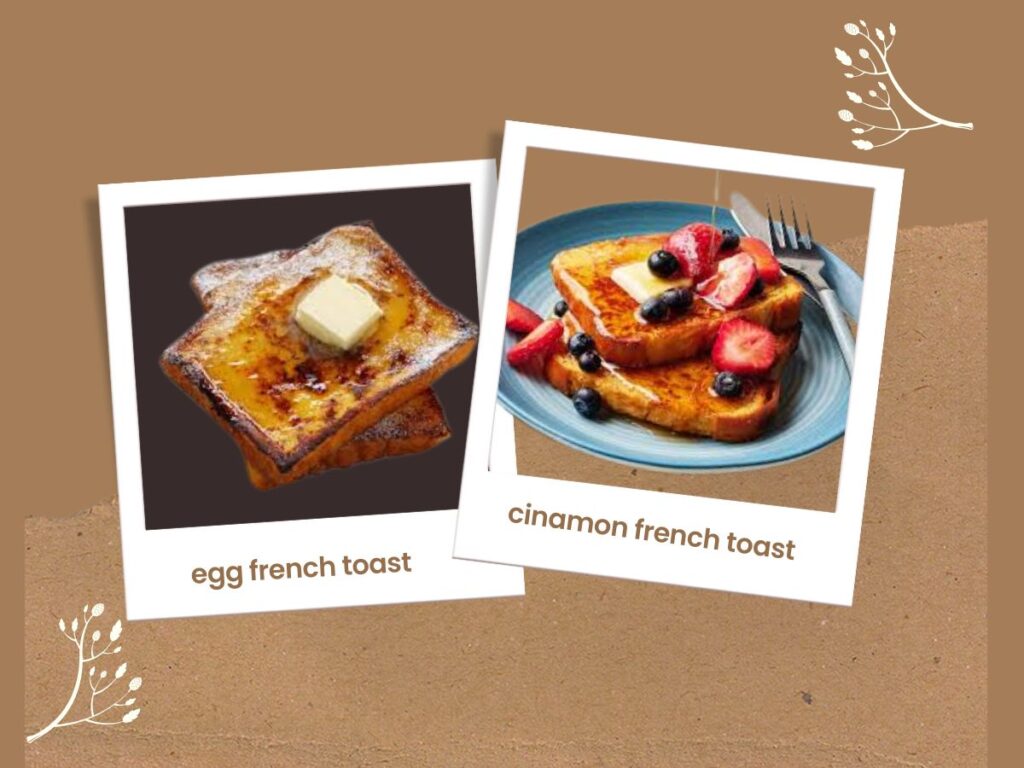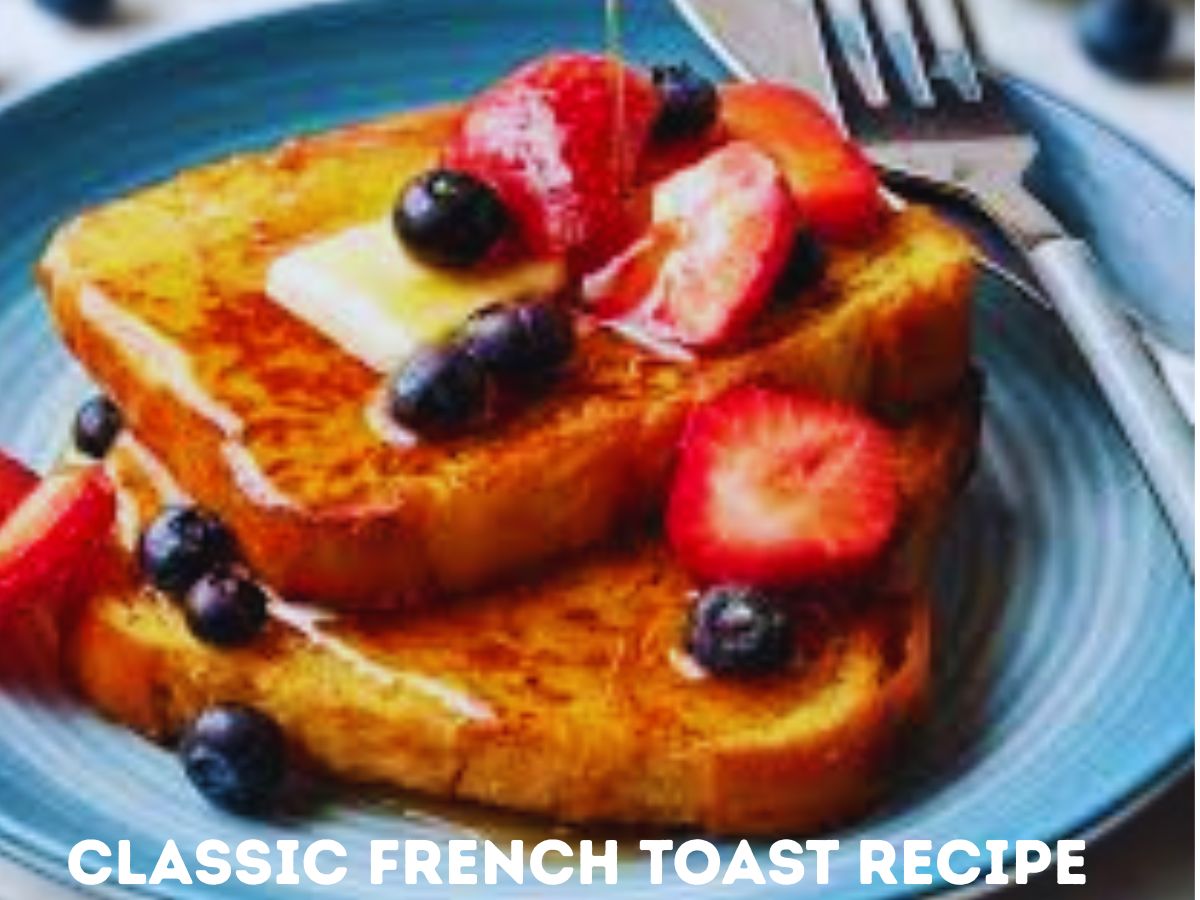You shouldn’t have to cook for a lot of people to wake up to the smell of golden, buttery French toast. This French toast recipe for 1 makes restaurant-quality food without any waste or leftovers, so you can enjoy a quiet morning or treat yourself to a special breakfast. In just five minutes of prep and cooking time, you’ll make the perfect single serving that is crispy on the outside, creamy on the inside, and tastes great.
In France, French toast is called “pain perdu,” which means “lost bread.” It turns regular bread into an amazing breakfast. Making French toast for one person is great because you can change everything to fit your tastes, from how much cinnamon you use to how crispy and golden brown the bread is. You can make exactly what you want without having to give up anything. You choose the sweetness and the toppings.
This complete guide tells you everything you need to know about French toast recipe for 1 person, including the secret restaurant tips that guarantee perfect results every time. This recipe can be made to fit your needs, whether you want a quick breakfast on a weekday, a healthy option to help you stick to your diet, or a sweet treat for lazy weekend mornings.
Recipe Overview
| Prep Time | 2 min |
| Cook Time | 3 min |
| Total Time | 5 minutes |
| Yield | 1 serving |
| Difficulty Level | Easy |
| Cuisine | French-American food |
This easy French toast recipe for 1 makes two perfectly cooked slices with a soft, custardy inside and a golden-brown outside. You probably already have all the ingredients you need for the recipe, and you only need one pan. It was made to be quick and perfect, so it’s great for busy mornings when you want something special without the hassle.
You can try out different flavours freely with the single-serving method. One day, you could try cinnamon, the next day, vanilla, or you could go savoury with herbs and cheese. Every time you try, it’s a low-risk chance to improve your skills and find the best way to make French toast for you.
Classic French Toast Recipe for 1
Ingredients
For the Custard Mixture:
- One big egg
- 2 tablespoons milk (whole milk preferred, but any type works)
- 1/4 teaspoon of vanilla extract
- ¼ teaspoon of ground cinnamon
- A little bit of salt
- 1/2 teaspoon of sugar (optional, for sweeter toast)
- For Cooking:
- 2 slices of bread (brioche, challah, or Texas toast are best)
- 1 tablespoon of butter
- Optional: cooking spray to make it even crispier
- To Serve:
- Syrup from maple trees
- Powdered sugar
- New berries
- Cream that has been whipped

Cooking Method
Step 1: Make the custard mixture
Break your egg in a bowl and beat it vigorously.
Now add the milk and vanilla extract. Whisk again until everything is well combined and a little frothy.
If you’re using cinnamon, salt, and sugar, add them now. Mix everything well. This is the key to making French toast that tastes good all the way through. The mixture should be a light yellow colour with cinnamon specks all over it.
Your custard should be thick enough to stick to bread but thin enough to coat it easily. Add a little more milk if it looks too thick.
Step 2: Soak the Bread
Take a non-stick pan or griddle and heat it on medium flame. Add half of the butter and let it melt while you soak the bread.
For soaking Put one slice of bread in the custard mixture. Let it soak for 15-20 seconds, pressing gently with a fork to help absorption.
Change the side of bread and let the other side soak for another 15–20 seconds. The bread should be soaked, but it shouldn’t fall apart. You might need a few extra seconds on each side if you’re using thick bread.
Don’t Over-Soak this is crucial—bread that’s too soggy will fall apart and won’t crisp up properly. You want it to be completely wet but still strong.
Step 3: Cooking to Golden Perfection
The butter should be melted and just starting to foam, but it shouldn’t be browning. This shows that the temperature is just right, between 325 and 350 degrees Fahrenheit.
Now gently lift the soaked bread, letting excess custard drip back into the bowl, and lay it in the pan. You should hear a gentle sizzle—not an aggressive sputter.
Cook each side at least for 90 seconds to 2 minutes, don’t touch it. Don’t give in to the urge to look too soon. The bottom should turn a deep golden brown colour with crispy edges.
Repeat Process for second slice as well.
Step 4: Last Touches
Move to a plate and let it sit for 30 seconds. This lets the custard on the inside finish setting while keeping the outside crispy.
Serve Right Away: French toast tastes best when it’s hot off the pan, when the difference between the crispy outside and the creamy inside is most clear.
Serving Suggestions and Storage Guide
Serving Ideas
Classic Sweet Toppings:
- A pat of butter melting on top of pure maple syrup
- Powdered sugar that has been sifted through a fine sieve
- New berries, like strawberries, blueberries, and raspberries
- Sliced bananas with honey drizzle
- Rosettes of whipped cream
Common Choices:
- Apples cooked in sugar and cinnamon
- Sliced strawberries and Nutella
- Berry compote and cream cheese
- Lemon curd with blueberries that are still fresh
- Peanut butter and banana slices
Savoury Variations:
- Don’t put sugar and cinnamon in the custard
- Add bacon and a fried egg on top
- Add avocado and hot sauce to the dish.
- Put cheese and ham between two slices
Tips for Storage
- Immediate Consumption Recommended: French toast tastes best fresh and hot. The outside that was crispy gets a lot softer when it cools down.
- Short-Term Storage: If you must store leftovers, place cooled French toast in an airtight container and refrigerate for up to 2 days.
- How to Reheat:
- Oven method: 350°F for 5–7 minutes on a baking sheet (this is the best way to keep them crispy)
- Toaster method: Set the toaster to the lowest setting to warm without burning.
- Don’t use the microwave: it makes things soggy and rubbery.
- Freezing Option: It’s possible to freeze single servings, but it’s not a good idea. If you’re making meals ahead of time, make several batches and freeze them with parchment paper between the slices. Please put it in a 375°F oven for 10 minutes to reheat from frozen.
Temperature Guide
- Cooking Temperature: A medium heat (325–350°F on the pan’s surface)
- Serving Temperature: 140–150°F (hot but not too hot)
- Storage Temperature: Refrigerate at 40°F or below within 2 hours
- Reheating Temperature: Put in the oven at 350°F until the inside temperature reaches 165°F.
Nutritional Information
| Calories | 285 kcal |
| Total Carbohydrates | 32g |
| Sugars | 6g |
| Protein | 12g |
| Fat | 12g |
| Fiber | 2g |
| Sodium | 1mg |
*Per serving (2 slices with basic recipe, no toppings)

Alternative Methods and Variations
Quick and Easy French Toast Recipe for 1
For ultra-busy mornings, here’s the streamlined approach:
1. One-Bowl Method: You don’t need measuring spoons to whisk the egg, milk, and cinnamon together in a shallow bowl.
2. Quick Soak: Soak each side of the bread in the mixture for only 10 seconds.
3. High Heat Cooking: For faster results, cook on medium-high heat for 60 to 75 seconds on each side.
4. Minimal Toppings: A quick dusting of powdered sugar and you’re done in under 4 minutes total.
Healthy French toast recipe for 1
- – 2 pieces of whole wheat or multigrain bread
- – One whole egg or two egg whites
- – Almond milk without sugar
- – Sugar substitute or honey
- – Use coconut oil instead of butter
Simple recipe for one serving of cinnamon French toast
- – Add ½ teaspoon more cinnamon
- – Add ⅛ teaspoon nutmeg
- – 1 teaspoon of brown sugar in the egg mix
- **To make sweet French toast:
- – Mix in 1 teaspoon of sugar with the eggs
- – Use Hawaiian sweet bread or brioche
- – Drizzle with honey before Cooking
How to Choose the Right Bread
- – Bread that is a day old works better than fresh bread (it absorbs more custard).
- – Thick slices (¾ to 1 inch) create the best texture
- – Avoid thin sandwich bread—it becomes soggy
Egg French Toast Recipe (No Flour Version)
This recipe is naturally flourless, making it perfect for gluten-conscious eaters when paired with gluten-free bread. The egg mixture gives the structure without needing any extra binders:
Why No Flour is Needed:
- Eggs act as strong binding agent
- Milk makes things wetter and richer
- The bread itself has the carbs in it
- Makes French toast that is less dense and lighter Some recipes call for adding flour to make the coating thicker, but real French toast only uses eggs for the best texture and taste.
Healthy Ingredients Options
- Use bread made from 100% whole wheat or sprouted grains
- Replace half the egg with egg whites (1 whole egg + 1 white)
- Use unsweetened almond or oat milk
- Use coconut oil instead of butter when cooking
- Don’t add any sugar at all
- Use Greek yogurt instead of whipped cream
- Fresh fruit without syrup
- A sprinkle of chia seeds or ground flax
- Natural Almond butter
- Alternatives to syrup that don’t have sugar
Nutritional Benefits: This variation reduces calories by approximately 30% while increasing protein and fibre content.
FAQS
How to make easy French toast for one person?
Making easy French toast for one person requires just five simple steps: whisk one egg with 2 tablespoons milk and cinnamon in a shallow dish, soak two bread slices for 15 seconds per side, melt butter in a pan over medium heat, cook each slice for 90 seconds per side until golden brown, and serve immediately with your favourite toppings. The entire process takes only 5 minutes from start to finish.
What is the best ratio for making French toast?
For every two slices of bread, you should use one egg and two tablespoons of milk. This creates the perfect custard consistency that soaks into bread without making it soggy. For one person, this ratio ensures complete coating with minimal waste. You can add a little more milk (up to 3 tablespoons) if you’re using very thick bread, but the base of 1 egg stays the same to keep the mixture together.
Is it okay to eat French toast on a diet?
When made carefully, French toast can be a healthy part of your diet. A basic serving has about 285 calories, which is fine for most meal plans. To make it better for your diet, use whole-grain bread for extra fibre, cooking spray instead of butter to cut down on fat, egg whites instead of syrup to lower cholesterol, and fresh fruit instead of syrup to top it off. The protein from eggs helps keep you full, making it a satisfying breakfast choice that can support weight management goals.
How to make two slices of French toast easy?
To make French toast for two slices, follow the same basic steps: mix one egg with two tablespoons of milk and spices, soak each slice for 15 seconds on each side, and cook both in a large pan over medium heat for 90 seconds on each side. The most important thing is to use a pan that is big enough to hold both slices without them touching. This will make sure that they cook evenly and have crispy edges. This single-serving size is great for one hungry person or as a light breakfast for two.
Is it possible to make French toast without vanilla extract?
Of course! You can make great French toast without vanilla, even though it adds a great flavour. The egg and cinnamon combination still creates an amazing taste. Alternatively, substitute with almond extract, maple extract, or a splash of orange juice for different flavour profiles. Some people like the taste of cinnamon and eggs without any extracts.
What type of bread works best for French toast?
Thick-sliced breads work best because they absorb custard without falling apart. Challah, brioche, and Texas toast are some of the best options because they are thick and rich. Day-old bread is better than fresh bread because it is a little drier and absorbs more custard. Avoid thin sandwich bread—it becomes too soggy. For healthier options, thick-cut whole wheat or sourdough works excellently.
Why is my French toast soggy?
French toast that is too soggy usually comes from soaking the bread for too long or using too low of heat. Soak the bread for only 15 to 20 seconds on each side—just long enough to coat it, not soak it. Cook over medium heat to create a crispy exterior that seals in moisture. Using bread that’s too fresh or thin also contributes to sogginess. For best results, let the bread sit out for a few hours or use bread that is a day old.
Can I make the custard for French toast ahead of time?
Yes! You can mix the eggs up to 24 hours ahead of time and keep them in the fridge covered. Please give it a quick stir before using, as ingredients may separate slightly. This makes getting ready in the morning even faster. But you should only soak and cook bread right before you eat it; soaking it ahead of time makes it mushy.
Conclusion
Mastering the art of French toast for one empowers you to enjoy restaurant-quality breakfast any day of the week without waste or excessive effort. This easy French toast recipe for 1 shows that you don’t have to give up taste or quality when you cook for yourself. You can make a delicious, golden breakfast in just five minutes with basic pantry items. It’s better than anything you’d find at a brunch spot.
The best thing about this single-serving method is that it can be used in many ways. Whether you’re following the classic recipe, experimenting with the healthy variation, or trying the secret restaurant techniques, you’re always just minutes away from breakfast satisfaction. The right amount of one egg to two tablespoons of milk for every two slices always works, and the easy method of medium heat and proper soaking guarantees golden perfection. Keep in mind that the way you make French toast is just as important as the ingredients. Taking those few extra seconds to properly soak your bread properly, maintaining consistent medium heat, and resisting the urge to flip too early makes the difference between mediocre and magnificent.
Every time you try, you can make your preferences more specific. For example, you might want more cinnamon, a custard that is a little sweeter, or the right amount of crispiness. Whether you’re starting your weekday with a quick, nutritious breakfast or treating yourself to a leisurely weekend morning with all the toppings, this French toast recipe for 1 adapts to your needs. It’s proof that solo Cooking doesn’t mean settling for boring cereal or skipping breakfast entirely. You deserve tasty food that is made just the way you like it, and now you have the perfect recipe to make that happen every day.









